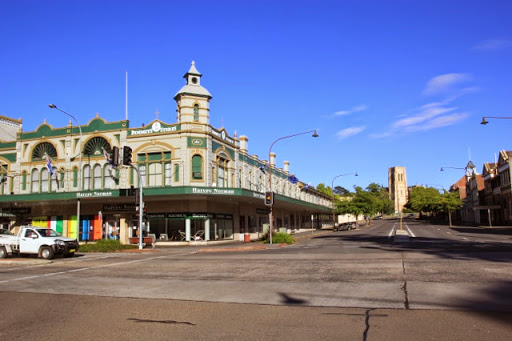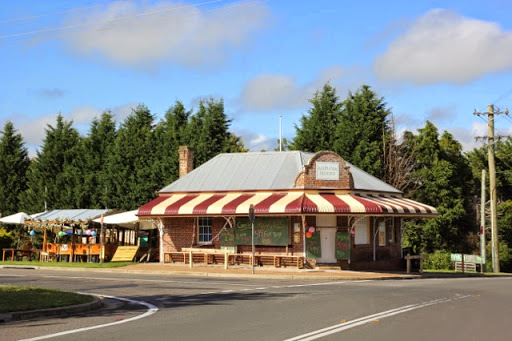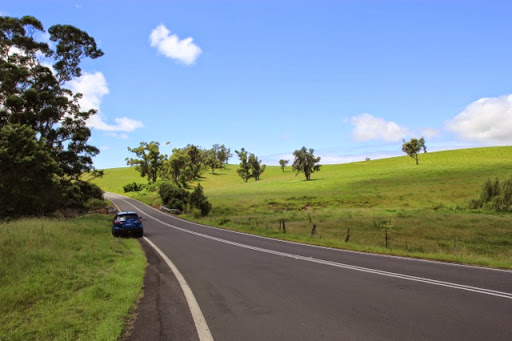PAH -PA-PA-PA-PA; YOUR'E GONNA FIND ME ...
Anticipation surely, is one of life's great joys. And when I leave the city's "stucco and smoke," why I sing in the car, as long as I can, before my wife and my dog make their displeasure felt - and not necessarily in that order! Usually it is the old Harry Webb number which drives them over the "appreciative cliff."
When you’re working in the city, and feeling rather small
And the people on the sidewalk, seem to form a solid wall
You're going to find me, Pah-pa-pa-pa-pa - way out in the country
Where the air is good and the day is fine
And the silver stream, is a poor man's wine
In the country, in the country
Oh Caruso, here's to you Mrs Robinson, and I sing with gusto, in tempo libre, alas more Dylan than Deano, but when I am on my own, who cares. Why on my last trip , on a warm summer's day, in a car bound for somewhere, a CD Kenny kept me company in duet, and never complained once! I drove through a summer country-side made green by unseasonal rain, lots of sunshine and 'pastoral' endeavour, beauty resplendent, and set my course for Canberra, the nation's capital, which many Australians see, erroneously, as a big country town anyway. (Boy are they wrong; Canberra readily plucks plaudits as funky and avant-garde, with fabulous architecture, national monuments and facilities, excellent roads, restaurants and coffee shops, award winning regional wines, and the country's politicians are only there half the time). But that is for another story.
One of the joys of retirement is the lassoing of time, dragging it where you want to go, rather than have it dictate to you when you need to be somewhere else. So I left the the super freeway which has cut the travel between Sydney and Canberra from five hours to three, and took to the wiggly bits of old roads on which you gritted your teeth when stuck behind trucks and sang endless verses of "the wheels of the bus," till the kids in the back seat fell asleep. I decided this time not to bypass Goulburn and take the opportunity to look at its quiet splendour, now without the roar of trucks and diesel fumes.
Goulburn, the major regional city of the Southern Tablelands, was New South Wales' first regional city when in the 1820s the Government gave land grants to pastoralists. With their sheep, cattle and policemen, they simply drove off most of the traditional aboriginal dwellers. A town was laid out in a grid system and it soon had a courthouse, police barracks, a hospital, Masonic hall, hotels, and a telegraph office. It became a city in 1865 and a major railway town on the line between Sydney and (Albury) Melbourne in 1867. It grew into a major wool scouring and selling centre when the NSW economy, and later the Australian economy, "rode on the sheep's' back." A huge concrete sheep, the Big Merino, on the old entrance to the city, symbolises the importance of the wool trade.

The rotunda, to sit and contemplate
The city, now a little over 20,000 people, oozes tranquility, the blood of commerce more seeping than pumping. It personifies "slowing down." People stroll and stop to chat, no need to jostle and elbow to make way. Like a stick in a slow moving stream, the car simply drove me to the fabulous Belmore park in the centre of town, quaint in its "Englishness." Orderly flower beds, a rotunda, monuments to the fallen and long gone Councillors, even a glass house with a spread of orchids and exotics. Oh and just in passing, a spotless loo, too! I just switched off the engine and sat for a moment, listening to the words of welcome from the birds, rekindling the simple pleasures of sounds that often escape you in the cities. And to think that a native of Goulburn, one George Lazenby, the only Australian to play James Bond, gave up all this tranquility, for the movies!

The fountain in Belmore Park

Rotunda and English Flower Garden
In the mid-Nineteenth century, Goulburn was blessed by the services of a Colonial architect with some wonderful civic buildings like the Italianate Court House, which replaced an earlier structure. Mind you, amid the beauty of its surrounds and gardens, not all who came there would have been so admiring. Some last views of its ornateness, only just before swinging from the gibbet. Goulburn retains the criminal association to this day. While capital punishment ended long ago, on the outskirts of the city is the State's maximum security prison, holding some of Australia's worst killers. Nearby the Police college.

The Old Goulburn Court House - the gallows were right next door
There was also the construction of a railway station and locomotive roundhouse, post office and a host of civic and church buildings, a main street of facades which still retain their rustic lines, turrets and cupolas, despite the 'spoilage' of much Twentieth century daubing and gaudiness. The streets are wide, from the days of turning bullock drays and stage coaches, or herding a mob of sheep through the place, and cars still park with their bums to the curb, once a "sure as eggs" way to create traffic jams. Now people have more time to be unhurried.

Post office tower from Belmore Park
There is plenty to see in and around Goulburn, and while some require you to hop back into the car, there is pleasure in strolling the main street. Plenty of yesteryear shops or to have a real country pie at the Paragon Cafe. I went for a coffee at the Roses Cafe, built in 1889, where I had an excellent "Country sized" slice of real carrot cake and a "pastoralist size" latte.

Roses cafe (above and below0

Afterwards, I wandered to the park and looked in on the hothouse before wandering up to St Saviour's Cathedral and then St Bridget's Catholic school. In1962 it had changed the national debate on State Aid to Private Schools. When officials told the school authorities they had to build an additional three loos to accommodate the 1000 school-children, the school elders said they didn't have the money, and the school children "went out on strike." In the end, the Government changed its mind; Catholic and other Private schools would get State Aid too ... and the Goulburn kids, extra loos. I went back to the park and had a parting free pee. Next time I will come back to look at the Railway Museum and see the city vista from the WWI Memorial Tower on Rocky Hill, the Wollondilly River, the sprawl of the gaol, the pastures with the bush to the horizon.

Wide streets and the view up to St Saviour's Cathedral
I am unsure about visiting the advertised museum at the former Kenmore Hospital, the Victorian-era "Hospital for the Insane," the then commonly referred to "Nut House, " a real life hell. In the mid 1960s, the hospital had 1400 inmates, but it was gradually wound down in the 1980s as psychiatric treatment became more studied and better facilities were built elsewhere. Some recalcitrant inmates back then were chained to beds or isolated in "wet rooms," which were simply hosed down each morning. There were padded cells to prevent self-harm, but no treatment for depression. Windows were barred, nightly screams rent the air, and there was the murder of a nurse by a former inmate (After which the Hospital Registrar took a rifle from a safe, and Wild West style, shot the felon). "Deviant sexuality" - homosexuality - and "self-love" - masturbation, - was subject to electric shock therapy, "to rid them of their ailment." The Hospital was abandoned only in the 2005 and while it soon became derelict, apparently there are now plans to convert the area into "modernised residential dwellings." Not for me. Ghosts and horror are not my meter.
On the return journey to Sydney, I again strayed. This time I had no qualms about bypassing the fast food outlets with their lousy coffee. I turned on to the green flanked Illawarra Highway, through the thimble-sized village of Sutton Forest with its iconic village store (closed), and through Moss Vale (Pop. 3000), to have a good coffee with old friends in little Robertson.

The old Corner Store at Sutton Forest - alas closed at the time.
The Southern Highlands is in many parts, the home for the toffs, prestigious properties and large comfortable houses, many with affluent, eminent, retirees, former sportsmen, politicians and popular "personalities). In the "old days," people came up from Sydney to escape the summer heat, stay in marvellous guest lodges, watch a bit of cricket on the Bradman Oval, walk their Poodles and Chihuahuas, and dine at a few select addresses. In winter, the nights were freezing, occasional snow, great for log fires and Tweed jackets, a bit of theatre and picnic races at nearby Bong Bong. Ah yes, the Bowral set, very country, decidedly twee!

The old world charm
Robbo, for Australians often denote affection and familiarity by adding an "o," is the self-proclaimed potato capital of Australia, and as usual in the "spudding-in" stakes of Australian "iconacry," there is a big concrete one, as you enter the village. It has, of course 'suffered from buffoonery" when an enterprising crew of night stealers once fitted some potato eyes and spectacles, a nose too. Apparently, a sad sack of potato peelers had the accoutrements removed. It seems, even in Robbo, when the chips are down, there is a pride in the concrete carbuncle.
We all met at the wonderful Light Horse Gallery, full of artworks, furniture, and adornments which could keep you perusing for ages. It frequently does for both the Canberra and Sydney sets, who "drop in" to Robbo, on their way to and from their separate haunts. There are lots of intriguing little houses, churches of course, and a long closed Cheese factory, now turned into purveyors of bric-a-brac and food for the famished. Set on the edge of the escarpment and boasting plentiful rainfall, it is green and rich farming country. In the 1920s Robbo had a hotel labelled "the most luxurious in the Commonwealth" - presumably the British Empire version, not merely the Commonwealth of Australia! The "hotel" served as a Signals base Women's auxiliaries and for trainee pilots in WWII, later as a hospital for wounded fliers, was turned into a Friary, became a hotel again, and is being returned to its former glory when it was grandly billed as the Fountaindale Grand Manor. Oh, if the walls could speak! Fliers, guests, nurses, monks! The wonderful Aussie film, "Babe" was filmed in the area, so the pigs might have some tails to tell as well!

The beautiful Light Horse Gallery at Robertson

A wooden church in Robertson

The old Cheese Factory in Robertson
I headed East, for the coast, past grand properties hidden behind a picket of trees and hedges, pines and boxwood, privacy personalised. I drove past the much acclaimed skyline tree-top walk, with its views of the escarpment; another time perhaps. I chose the switchback squiggle down the mountainside to the hamlet of Jamberoo over the busier Macquarie Pass to Wollongong and the coast; same rainforest with its giant palms, same spectacle, but driven at my pace, not that of dictators.
There is nothing so annoying about enjoying the countryside, as having an other driver, "up your bum." I fully understand that grandpa pace is not to everyone's liking and find a lay-by to let them fly by. Ahh, country airs, I hear you snigger, but it is more about being able to enjoy the views and touch the sounds, the calling of the bush, the tinkle of the streams.

Pasture and bush on the road to Jamberoo

Moo-ve, mate

Milkshake anyone?
Country journey over, steel towns ahead. Time for one last Pah-pa-pa-pa-pa, I turned on to the freeway, with its concrete sound barriers and mini Berlin Wall median strip. I got out my CD of Aida and drove to the more edifying Triumphal March. Somehow, it was soothing too, drowning out the noise of those elephantine coal trucks, passing me while going up the Bulli Pass, on the road to Sydney.

Oh the open road (I think that I will never see, a billboard as lovely as a tree, indeed unless the billboards fall, I'll never see a tree at all. Ogden Nash)
Winfred Peppinck is the Tales of the Traveling Editor for Wandering Educators.
All photos courtesy and copyright Winfred Peppinck
